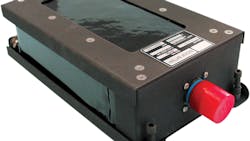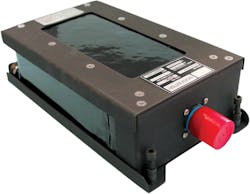Small Batteries Deliver Big Power to UAVs
This file type includes high-resolution graphics and schematics when applicable.
Advances in UAV/drone technology have created a need for small lithium batteries that can pack large amounts of power into very small spaces. Design engineers are continually seeking to make UAVs smaller and lighter to benefit aerodynamics and range of flight. Large UAVs typically utilize gasoline engines, with lithium batteries being deployed to reduce size and weight when powering specific sensor or instrumentation platforms or for emergency backup power requirements.
Military-Grade Lithium Metal-Oxide Batteries
Lithium metal oxide batteries deliver a nominal voltage of 4 V, and a discharge capacity of 135 to 500 mAh, capable of handling 15-A pulses. They are constructed with a carbon-based anode, multi-metal oxide cathode, organic electrolyte, and shut-down separator for enhanced safety, and should feature an extremely low self-discharge and a wide operating temperature range (-40° to 85°C). For example, a UAV utilized for unmanned air reconnaissance is deploying lithium metal oxide batteries to create smaller, lighter battery packs for the emergency recovery system, which enables the aircraft to glide to a safe landing in case of a catastrophic system failure.
The batteries should comply with MIL-STD 810G specs for vibration, shock, temperature shock, salt fog, altitude, acceleration (50,000 gn), and spinning (30,000 rpm), and also conform to UN 1642 and IEC 60086 standards for crush, impact, nail penetration, heat, overcharge, and short circuit, making them ideal for use in guided munitions.
Unlike reserve/thermal batteries, lithium metal oxide cells permit instantaneous activation without the need for squibs or gas generators, allowing power to be drawn intermittently so the circuitry can be periodically tested for system readiness. These cells also avoid the high internal temperatures created by reserve/ thermal batteries, thus eliminating the need for bulky layers of thermal insulation, or the squibs, gas generators, and external heating elements required by silver zinc batteries.
Ruggedized Li-ion Batteries
Rechargeable lithium-polymer (LiPo) batteries, which are essentially the same as consumer-grade lithium-ion (Li-ion) rechargeable cells, have traditionally powered miniature UAVs flown by consumer hobbyists.
Consumer-grade Li-ion cells are generally not intended for long-term deployment in mission-critical applications involving extreme environmental conditions. Consumer grade Li-ion cells have a life expectancy of less than five years and 500 recharge cycles and operate within a moderate temperature range of 0° to 40°C. However, if the miniaturized UAV is intended for use in remote, inaccessible locations or extreme temperatures, then design engineers should strongly consider the use of an industrial grade Li-ion battery, as these ruggedized cells can deliver up to 20 years of operating life with 5,000 full recharge cycles, an expanded temperature range of -40° to 85°C, and the ability to deliver high pulses (5 A for a AA-size cell).
Industrial-grade Li-ion cells are also constructed with a hermetic seal, which is superior to the crimped seals found on consumer-grade rechargeable batteries, which may leak. Industrial-grade rechargeable Li-ion batteries are being deployed in miniature UAVs that soldiers carry into the battlefield and deploy as needed to observe enemy positions.


